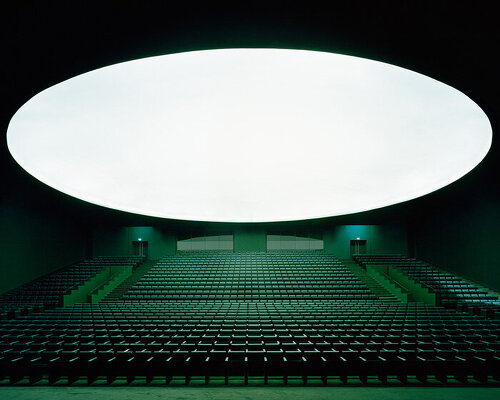A new gem for a university Campus in rabat, morocco
The new Centre de Congrès, designed by Bofill Taller de Arquitectura, has been completed on the Rabat campus of Université Mohammed VI Polytechnique in Morocco. Opened in autumn 2024, the building marks the first phase of the campus master plan and establishes a civic presence for the university, while supporting a range of academic, cultural, and public programming.
Located between two distinct zones of the campus, the building occupies a transitional site and functions as a spatial connector. A sequence of tiled porticos marks the approach from both directions, drawing the same material language of the exterior paving into the lobby and gathering areas. This continuity between inside and out is key to the architectural logic, reinforcing the idea of permeability through a deliberate treatment of surface and threshold.
image © Gregori Civera
porous geometries by bofill taller de arquitectura
With the Centre de Congrès in Rabat, Morocco, the team at Bofill Taller de Arquitectura creates a hinge between the university’s main axis and a denser cluster of academic buildings. By resolving this moment of connection, the project plays an infrastructural and symbolic role. On the urban level, it serves as a passageway. On the architectural level, it articulates a calm interplay between form, volume, and use.
The architects approach the program with a clear geometric strategy, arranging the plan around a square and a circle. At the center, a cubic auditorium defines the main performance space. Encircling it, a sweeping curved wall houses smaller conference rooms, lounges, and auxiliary facilities. These are interwoven with shaded walkways, open patios, and areas for informal gathering.
The building’s outer ring is defined by arches that rise from the ground at the four corners and lift away elsewhere, creating shaded porticoes while maintaining openness across the facades. This strategy provides both scale and porosity, offering a sense of arrival without enclosing the building entirely. Meanwhile, it allows for cross-ventilation and varying light conditions throughout the day.
the Centre de Congrès is located at a key junction between two areas of the Rabat campus
carved arches enclose new Centre de Congrès
Materials within the Centre de Congrès in Morocco were selected by Bofill Taller de Arquitectura for consistency and clarity. Bright ceramic tiles along the walls, floors, and street-level paving reflect the light and establish a visual rhythm across the site. In contrast, interior finishes rely on a warm, restrained palette, with custom furniture and lighting supporting the broader design intention.
The interior of the main auditorium at the Centre de Congrès is defined by a sense of controlled monumentality. Seating is arranged in a precise fan formation around a central stage, beneath a vast circular oculus that casts an even, diffuse glow across the space. This luminous ceiling element flattens the visual field, drawing the eye upward while distributing light evenly across the stepped seating. Walls are rendered in a deep green tone, matched by the upholstered chairs, creating a hushed and immersive environment.
Bofill Taller de Arquitectura organizes the building around a circular wall enclosing a square auditorium
porticos and tiled surfaces create visual and physical continuity across indoor and outdoor areas
grand arches touch the ground at the corners and lift away elsewhere for a porous facade
the project supports events from academic lectures to public performances and exhibitions
the design emphasizes clarity of circulation and flexibility of use
the Centre de Congrès contributes to the identity and connectivity of the university master plan
project info:
name: Centre de Congrès Rabat
architect: Bofill Taller de Arquitectura | @bofillarquitectura
location: Université Mohammed VI Polytechnique, Rabat, Morocco
photography: © Gregori Civera | @gregori_civera
The post bofill taller carves elongated arches around deep green auditorium in morocco appeared first on designboom | architecture & design magazine.

